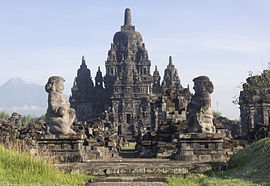Buddhist temple

| Part of a series on |
| Buddhism |
|---|
 |
A Buddhist temple or
Architecture
Its architecture and structure varies from region to region. Usually, the temple consists not only of its buildings, but also the surrounding environment. The Buddhist temples are designed to symbolize five elements: fire, air, water, earth and void (space).[2]
India
The design of temples in India was influenced by the idea of a place of worship as a representation of the universe. For Buddhist temple complexes one tall temple is often centrally located and surrounded by smaller temples and walls. This center surrounded by oceans, lesser mountains and a huge wall.[3]
A
Some of the earliest free-standing temples may have been of a circular type.
-
Bodhi tree temple depicted in Sanchi, Stupa 1, Southern gateway
-
Remains of the circular rock-hewn circular Chaitya with columns, Tulja Caves
Indonesia

Buddhism is the second oldest religion in
According to some Chinese source, a Chinese Buddhist monk
in Sumatra, and numerous of statues or inscriptions from the earlier history of Indonesian Hindu-Buddhist kingdoms.
During the era of
In contemporary
Japan

Japanese Buddhist temples typically include a Main Hall.
A distinctive feature is the
Thailand

Buddhist temples in
Sri Lanka

Buddhist temples in Sri Lanla are known as 'Pansala' or 'Viharaya' in
See also
- Gautama Buddha
- Dambana
- Dhamma
- Sangha
- Three Refuges
- Five Precepts
- Pāli Canon
- Uposatha
- Cetiya
- Sri Maha Bodhi
- Vihara
- Wat
- Kyaung
- Burmese pagoda
- List of Buddhist temples
- Buddhist architecture
- Aniconism in Buddhism
References
- ^ "New York Buddhist Temple for World Peace". Kadampanewyork.org. 1997-08-01. Archived from the original on 2012-06-11. Retrieved 2012-06-20.
- ^ "Buddhism: Buddhist Worship". BBC. 2006-04-10. Archived from the original on 2018-10-02. Retrieved 2017-03-06.
- ^ O'Riley, Michael Kampel (2013). Art Beyond the West. Pearson Education. p. 61.
- ^ "Sowing the Seeds of the Lotus: A Journey to the Great Pilgrimage Sites of Buddhism, Part I" by John C. Huntington. Orientations, November 1985 pg 61
- ^ Buddhist Architecture, Huu Phuoc Le, Grafikol, 2010 p.240
- ^ A Global History of Architecture, Francis D. K. Ching, Mark M. Jarzombek, Vikramaditya Prakash, John Wiley & Sons, 2017 p.570ff Archived 2023-07-02 at the Wayback Machine
- ^ Buddhist Architecture, Huu Phuoc Le, Grafikol, 2010 p. 233–237. Archived 2023-10-31 at the Wayback Machine
- ISBN 9788170173120. Archivedfrom the original on 2023-10-31. Retrieved 2019-11-11.
- ISBN 9780984404308. Archivedfrom the original on 2023-10-31. Retrieved 2019-11-11.
- ^ "Buddhism in Indonesia". Buddha Dharma Education Association. Buddha Dharma Education Association. 2005. Archived from the original on 2002-02-14. Retrieved 2006-10-03.
- ^ Depkumham.go.id Archived 2010-02-12 at the Wayback Machine
- ^ "Replika Candi Pawon". Vihāra Jakarta Dhammacakka Jaya. Archived from the original on 2023-08-14. Retrieved 2020-10-31.



![Relief of a multi-storied temple, 2nd century CE, Ghantasala Stupa[8][9]](http://upload.wikimedia.org/wikipedia/commons/thumb/7/75/Andhra_pradesh%2C_santuario_a_pi%C3%B9_piani%2C_da_ghantasala%2C_90-110_ca..JPG/120px-Andhra_pradesh%2C_santuario_a_pi%C3%B9_piani%2C_da_ghantasala%2C_90-110_ca..JPG)
